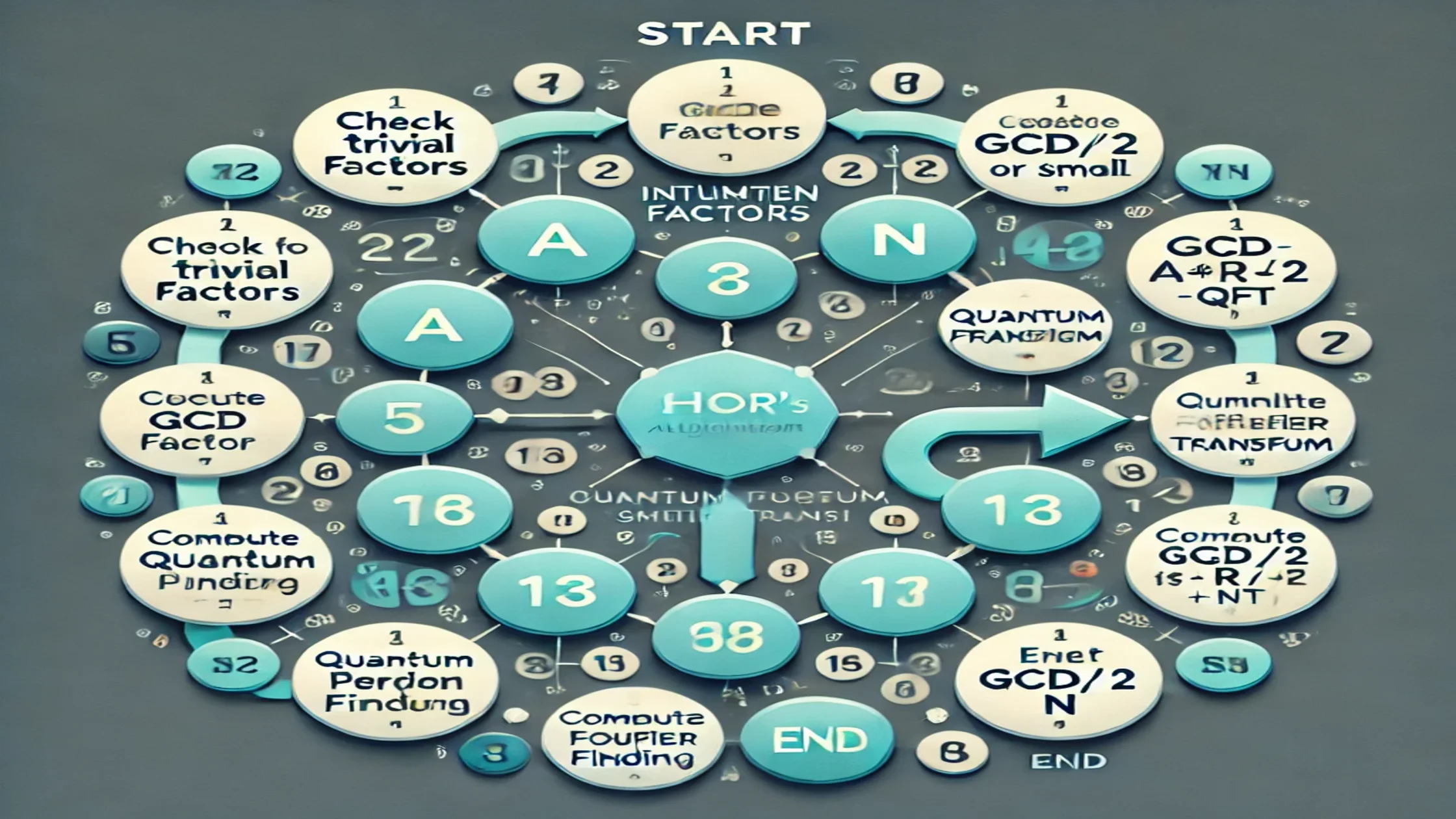What is Shor’s Algorithm? Simple to Advance
Algorithms in quantum computers have become like pillars supporting the demonstration of quantum systems in this fast-moving world. In this regard, Shor’s algorithm has influenced the quantum and classical computation worlds. This quantum algorithm was invented by mathematician Peter Shor way back in 1994. Shor’s Algorithm is a quantum algorithm that can factor large composite numbers into their prime factors very efficiently, far outperforming classical algorithms, which have a hard time factoring large numbers. Quantum algorithms breakthrough both cryptography and prime factorization in the most fundamental ways by solving the problem in polynomial time instead of exponential time. This makes it a potential threat to encryption systems like RSA, which rely on the difficulty of prime factorization for security. In this blog, we will be researching what Shor’s Algorithm is, how it works, and why it is viewed as a breakthrough in the computing world.
Covered Contents
ToggleThe Problem It Solves: Prime Factorization
At the heart of Shor’s Algorithm lies a problem, which mathematicians and computer scientists have grappled with for centuries: prime factorization. Prime factorization is the process by which one can decompose any large composite number into its prime factors. For example, prime factors of 15 would be 3 and 5, since 15 = 3 * 5.
Prime factorization is very straightforward for small numbers but becomes computationally expensive and difficult as the size of numbers to be factored increases. For numbers of several hundred or thousands of digits, the problem is even considered to be computationally infeasible using classical algorithms. The time it could take to factor in such enormous sizes of numbers is exponential in the size of the input.
This is the base of the hardness of many popular modern cryptographic algorithms, such as RSA encryption, which relies upon the fact that while it’s easy to multiply two large primes together, breaking the product they produce back up into its factors is extremely challenging for a traditional computer. So, this gives rise to some asymmetry—a very important difference between the capabilities of classical versus quantum computers for certain types of problems.
Enter Shor’s Algorithm: The Quantum Solution
This problem, however, is solvable by a quantum algorithm in Shor’s Algorithm. Simply put, it is an algorithm that is proposed to factor large numbers much more efficiently than any classical algorithm would. Notice again that Shor’s Algorithm isn’t simply a quantum version of existing factorization algorithms: it fundamentally alters how the problem might be approached, making use of quantum properties to achieve results in polynomial time rather than exponential time.
To put this in context, while classical algorithms for prime factorization take exponential time to solve (i.e., their runtime increases very rapidly as the size of the number increases), Shor’s Algorithm can solve the problem in polynomial time—meaning the time it takes to factor a number grows much more slowly as the size of the number increases. This efficiency boost comes from the quantum properties of superposition, entanglement, and interference, which classical systems cannot replicate.
How Does Shor’s Algorithm Work?
Shor’s Algorithm is composed of two central components: the quantum Fourier transform and periodicity finding. A detailed explanation of the whole algorithm would be heavy to read unless you have advanced knowledge of quantum mechanics and number theory; hence, I can describe it step by step for easier comprehension.
Reduction to Periodicity Finding:
One of the starting steps in the Shor algorithm is the transformation of the difficulty of prime factorization into another problem of finding some period of a particular function. This problem does not seem particularly difficult: with a randomly chosen number, prepare a function where periodic behavior must be found by a period-finding algorithm and solve the periodicity-finding problem efficiently within quantum algorithms.
Quantum Fourier Transform:
The quantum Fourier transform is another central operation used in Shor’s Algorithm. It is analogous to the Fourier transform used classically, used to decompose a signal into its constituent frequencies. In this case, though, the QFT is to extract periodicity information from the quantum state being considered. Thus, it permits the algorithm to find the period of the function efficiently.
Classical Post-Processing:
After running the quantum algorithm, there remains some slight classical post-processing to be conducted. The quantum part produces the number which consists of information for the period of the function under consideration. During the classical stage, the found number is processed to get the original composite number prime factors.
The quantum section of Shor’s Algorithm computes exponentially faster than any known classically-based approach to factoring large numbers—computations intractable even for the mightiest classical supercomputers today, but those that can easily be solved with Shor’s Algorithm in minutes or hours at most.
Why Is Shor’s Algorithm Important?
Shor’s Algorithm often is cited among the key motivations for why it is considered an almost revolutionary form of technology to be quantum. Let’s learn why:
Breaking RSA Encryption:
As discussed above, RSA encryption is based on the difficulty of factoring large composite numbers. Much of modern cryptography, including secure online communication and banking systems, depends on this assumption. If a large-scale quantum computer were to implement Shor’s Algorithm, it could break RSA encryption by factoring the large numbers used in the system, rendering current cryptographic protocols vulnerable. This has led to a kind of race in developing methods that are post-quantum cryptography. So, it does not get broken by the quantum computers.
Cryptography and Cybersecurity:
This might sound ominous and indeed will sound ominous, but once again, it drives innovation in the field of quantum-resistant cryptography. Researchers are now working on algorithms resistant to quantum attacks. Those algorithms are called post-quantum cryptography algorithms; they are devised to be quantum-computer-security-resistant against all adversaries who use Shor’s Algorithm. Today, the crypto community is gearing up for this future when ubiquitous quantum computing changes the rules of the game.
Implications at Theoretical Levels:
Even though quantum computers capable of performing Shor’s Algorithm are still years from actual implementation, the finding of this algorithm established deep theoretical implications. Essentially, the discovery revealed that quantum computers could solve specific problems much faster compared to their classical counterparts, thus opening ways to solutions to problems once thought to be intractable.
Challenges and Limitations
Shor’s Algorithm also faces several challenges:
Quantum Hardware Limitations:
Current quantum computers are still in early-stage development, and they are not powerful enough to apply Shor’s Algorithm on large numbers. Present quantum computers are mostly NISQ devices; this means they have an error-prone nature and are not large enough to allow the kind of complex calculations required for the practical application of factorization.
Quantum Error Correction:
One of the biggest challenges in scaling Shor’s Algorithm is the problem of quantum error correction. Quantum systems are very fragile, and even slight disturbances can cause errors in computations. Therefore, before Shor’s Algorithm can be practically implemented at scale, much progress in quantum error correction techniques is needed.
Conclusion
Shor’s Algorithm is a groundbreaking development in the quantum computing field that promises to transform the way problems are approached in cryptography, number theory, and computation. Even though there is still much work to be done in terms of quantum hardware and error correction, the algorithm has already shown that quantum computers can solve certain problems much more efficiently than any possible classical system. As the field continues to advance within quantum computing, Shor’s Algorithm will form a significant niche area of advancement, with direct implications for what the future looks like in computation and cybersecurity fields.
The critical period for our technological landscape shall be the subsequent decades, primarily in how reshaping is given by quantum computation, with the algorithm of Shor at its forefront.
Read More:



3 thoughts on “What is Shor’s Algorithm? Simple to Advance”